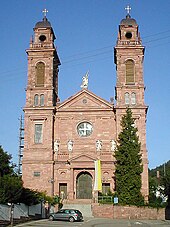Neckar valley sandstone
The reddish Neckar valley sandstone , also known as Neckar valley hard sandstone , is mined in the vicinity of Eberbach in Baden-Württemberg . The feldspar-bearing sandstone with rock fragments was created in the lower red sandstone .
geology
In Central Europe, the red sandstones extend over an area from France and Luxembourg in the west to Poland and Belarus in the east and from southern Switzerland to Scandinavia in the north. Since the climate in the Red Sandstone Age fluctuated between humid and dry, fossil deposits of plants and animals are rare in this hostile environment. In the Lower Buntsandstein, sand deposits in shallow seas were red in color, rarely as yellowish-gray to whitish layers. The sediment compacted and solidified into sandstones.
Rock description
The fine to medium-grain Neckar Valley sandstone is rarely coarse-grained. It is pale red with yellowish red spots and partially with white flaming. Its storage is mostly parallel and oblique. Pinhead -sized limonite nests that are evenly distributed in the rock are characteristic of this sandstone . There are also clay galls several centimeters in size. The average size of the mineral grains is 0.22 millimeters. The distinctive pale red color is due to the thin layers of iron oxide or iron hydroxide that surround the individual mineral grains.
Mineral inventory
The components of the Neckar valley sandstone consist of 55 percent quartz , 25 percent rock fragments, 22 percent alkali feldspar and the accessories muscovite , rutile , tourmaline , zircon and other opaque mineral grains. The binding agent is clayey-ferritic (clay-iron) and also pebble (silica). This sandstone is moderately to good weather resistant and it sands, flakes and peels off. A typical phenomenon for the Neckar valley sandstone is the weathering of limonite nests.
Use and occurrence
This sandstone is used as a brick for solid buildings, paving stones and curbs, floor and stair coverings, for tombs and in sculpture, because it is coarsely grained in some areas. Neckar valley sandstone was used at Heidelberg Castle , the Heiliggeistkirche in Heidelberg , the Old Bridge in Heidelberg , the Church of St. Johannes Nepomuk and the Evangelical Church as well as the castle ruins in Eberbach. But it was also used for bank constructions.

Quarries near Eberbach are located near Gaimühle, Rockenau and on the Kranichberg. The quarries between Heidelberg Castle and Wolfsbrunnen near Schlierbach , from which the building blocks of the Ottheinrichsbau and Friedrichsbau of Heidelberg Castle were taken, have long been abandoned.
In some cases, Odenwald sandstone and red Main sandstone, such as the Miltenberg sandstone, are macroscopically indistinguishable from the Neckar valley sandstone. A distinction in these cases is only possible by means of scientific petrological examinations in rock science laboratories, if necessary.
literature
- Wolf-Dieter Grimm: picture atlas of important monument rocks of the Federal Republic of Germany. Edited by the Bavarian State Office for Monument Preservation. Lipp-Verlag, Munich 1990, ISBN 3-87490-535-7
- W. Werner, J. Wittenbrink, H. Bock, B. Kimmig, with contributions by F. Grüner, K.-J. Stein, K.-J. Koch, R. Hildebrandt and W. Reiff: Natural stone from Baden-Württemberg - occurrence, condition and use , - 765 p., 1248 fig., 45 tab .; Freiburg i. Br. (L.-Amt. Geol., Rohst. Bergbau), 2013 ISBN 978-3-00-041100-7 .
Individual evidence
- ↑ Red sandstone on the website of the Ministry for the Environment, Nature Conservation and Transport, Baden-Württemberg . Retrieved July 2, 2010
- ↑ a b c Grimm: Monument rocks. Rock no.068 (see literature)
- ^ Grimm: memorial stones. P. 158
Coordinates: 49 ° 29 ′ 57.9 " N , 9 ° 2 ′ 26.7" E



